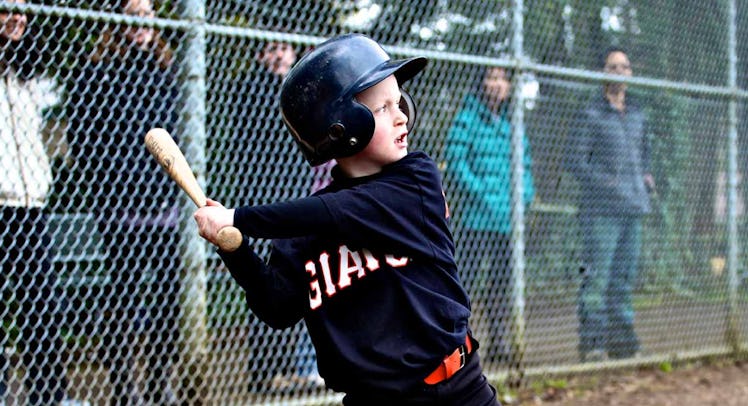The 5 Most Common Problems With Kids’ Baseball Swings — and How to Fix Them
Expert suggestions for helping your Little Leaguer go long.

Baseball is deceiving. Watch enough Sports Center highlights or spend too much time playing MLB: The Show and it seems like all a hitter needs to do is swagger up to the plate, adjust his cup, and whack the crap out of the ball. Of course, the baseball swing is a complex, complicated movement, one that requires players to consider hundred little tweaks that need to happen once they’re in the batter’s box — not to mention all the other cues going on around them.
Good swing mechanics start at a young age. And there are some common errors that make it nearly impossible for young hitters to make contact with the ball, let alone knock it past the pitcher. Luckily, they can be easily corrected. Here are five most common swing mistakes kids make — and what you can do to help correct them.
The Problem: Starting High and Finishing Low
“Especially at a young age, kids are taught to simply make contact, and are almost encouraged to hit the ball onto the ground,” says Rob Kotzen, a former division 1 baseball player and current hitting coach with the sports app Coachup. “This can lead to a swing path that resembles that of a lumberjack chopping down a tree (the swing starts high and finishes low). “Best case, this results in a ground ball; worse case is it’s a weak hit or you miss it.”
The Solution: The chopping angle is also called a launch angle, and data shows that balls hit farthest in the major league have an upward launch angle of 10 to 18 degrees. “When they’re making contact with the ball, they should swing up through the ball,” to achieve that angle, Kotzen says. The goal should be hitting a line drive with that launch angle. “There are five people in the infield and three in the outfield. Furthermore, that’s where the fence is. Shouldn’t we aim for it?”
The Problem: All Arms, No Legs
“Kids can have a bad habit of trying to do too much with the muscles in their arms, but the biggest muscles we have are in our legs,” Kotzen says. A telltale sign of this mistake is when the batter’s legs are overly straight or too close together during the swing.
The Solution: While it probably originated elsewhere, the expression “put your ass into it” readily applies to hitting a baseball. Specifically, the rear butt cheek plays a critical role in ass-borne slugging power. It begins with the stance: legs spread with feet at hip width or wider, knees bent. “The cue I use is stay in your legs longer,” Kotzen says. “That manifests in keeping the legs bent and using your back foot, hip and butt cheek to push the swing.” This is another prompt to address the same problem: “Start from the ground up. The swing should start in the toes, move to the feet, then calves, then quads, and then transfer that energy to the upper body.”
The Problem: Failing to Step Toward the Pitcher
Kids can sometimes bypass the small step made with the front foot that initiates the swing. Imagine a rubber band stretched between the feet and the hands. Stepping the front foot toward the mound loads that rubber band with potential energy. “I see kids step into the batter’s box with their hands near their back shoulder. The pitch comes and they just move their hands toward their front shoulder,” says Kotzen.
The Solution: “We want to step toward the pitcher with the front foot, and simultaneously load our hands back toward the catcher,” says Kotzen. Some hitters kick the front foot back slightly before stepping forward, which loads up that potential energy even more effectively. “When that’s done right, the torso and shoulders rotate toward the catcher, and unload all that power toward the pitcher in the swing.”
The Problem: Swinging Too Soon
“A lot of young players get the bat loaded properly but use the hands too soon,” Kotzen says. The underlying problem is that the hitter leads the swing with the arms or, more generally, that the swing is out of order in some way.
The Solution: Focus on the navel. “Make sure the the belly button is the thing you’re most worried about going first as you uncoil,” Kotzen says. “If your belly button is uncoiling, then the hips will move before the hands.” Studies of major leaguers have shown that, other than the launch angle, bat speed most affects hitting power. The lesson is, “Don’t try to swing harder. Swing faster,” which begins with the human lint trap.
The Problem: Forgetting to Finish
You ever watch kids playing and it looks like the ball is hitting the bat, rather than vice versa? That’s because they’re halting mid-swing. “At the split second they make contact, the swing ends,” Kotzen says. “That’s when you see that recoil, whether from fear or they don’t know what to do, and their hands sting.”
The Solution: Maintain follow-through to the end of the motion. Swinging a bat is like entering a highway on a curved onramp: you start slow and end fast. “Accelerate through the contact. That’s the fastest part of the swing.”